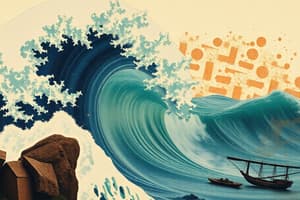Podcast
Questions and Answers
What is the most common cause of tsunamis?
What is the most common cause of tsunamis?
- Volcanic eruptions
- Landslides
- Earthquake activity (correct)
- Meteorite impacts
Which of the following can lead to tsunamis as a secondary effect?
Which of the following can lead to tsunamis as a secondary effect?
- Overfishing practices
- Coastal erosion
- Underwater volcanic eruptions (correct)
- Tsunami preparedness drills
Which phenomenon is associated with the displacement of large volumes of water, often linked to earthquakes?
Which phenomenon is associated with the displacement of large volumes of water, often linked to earthquakes?
- Meteorite impact
- Human activities
- Underwater landslides (correct)
- Glacial calving
In which region is glacial calving, a potential cause of tsunamis, most likely to occur?
In which region is glacial calving, a potential cause of tsunamis, most likely to occur?
What role do human activities play in generating tsunamis?
What role do human activities play in generating tsunamis?
Flashcards are hidden until you start studying
Study Notes
Causes of Tsunamis
-
Earthquake Activity
- Most common cause.
- Occurs primarily at tectonic plate boundaries.
- Subduction zones: One plate moves under another, displacing water.
-
Volcanic Eruptions
- Eruptions can cause sudden displacement of water.
- Explosive eruptions may generate pyroclastic flows that enter the ocean.
-
Landslides
- Underwater landslides can displace a large volume of water.
- Can be triggered by earthquakes, volcanic activity, or erosion.
-
Glacial Calving
- Large chunks of ice breaking off glaciers can create waves.
- Typically occurs in polar regions.
-
Meteorite Impacts
- Rare but can generate significant waves.
- The impact displaces water quickly, creating tsunamis.
-
Human Activities
- Coastal construction or underwater mining can disrupt sediment and generate waves.
- Reservoir-induced seismicity from large dams may also contribute.
Key Points
- Tsunamis can have multiple causes, primarily related to geological processes.
- The speed and impact of a tsunami depend on the size of the initial displacement.
- Understanding the causes is crucial for tsunami prediction and hazard mitigation.
Causes of Tsunamis
- Earthquakes are the leading cause, primarily occurring at tectonic plate boundaries where one plate subducts under another, resulting in water displacement.
- Volcanic eruptions can displace water rapidly; explosive eruptions may produce pyroclastic flows that enter the ocean, generating tsunami waves.
- Underwater landslides can occur due to earthquakes, volcanic activity, or erosion, causing significant water displacement and subsequent wave generation.
- Glacial calving, wherein large ice chunks break off glaciers, typically creates waves in polar regions, contributing to tsunami formation.
- Meteorite impacts, while rare, can produce powerful tsunamis by displacing water upon impact, resulting in significant waves.
- Human activities, such as coastal construction and underwater mining, can disrupt sediment and generate waves; large dams may also induce seismicity impacting tsunami risk.
Key Points
- Multiple geological processes contribute to the formation of tsunamis.
- The magnitude of the initial displacement directly influences the tsunami's speed and impact.
- Knowledge of tsunami causes is essential for effective prediction and hazard mitigation strategies.
Studying That Suits You
Use AI to generate personalized quizzes and flashcards to suit your learning preferences.




